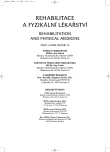Vibration: Neurophysiological Aspects and Possibilities of Clinical Application
Authors:
B. Paráková; M. Mikova; A. Krobot
Authors‘ workplace:
Klinika rehabilitace a tělovýchovného lékařství LF UP a FN, Olomouc
primář MUDr. A. Krobot, Ph. D.
Published in:
Rehabil. fyz. Lék., 15, 2008, No. 1, pp. 11-17.
Category:
Original Papers
Overview
Vibration in medicine encompasses various forms and effects. The authors present mechanical vibration as a stimulus of primary endings of strongly myelinated afferent fibers of muscular spindle. In rehabilitation medicine (physiotherapy) we apply predominantly local vibration of muscles. Vibration applied on the muscle may induce contraction – tonic vibration reflex. By applying vibration we can also influence perception of the extremity position up to the cortical level. We can be also testing experimentally proprioception. The all-body application of vibration, despite its present popularity, is still questionable and if applied for longer period of time, increased health risk cannot be excluded.
Key words:
vibration, electromyography, EMG, muscular spindle, muscular contraction
Sources
1. Véle, F.: Fyziologie mechanoreceptorů. In: Jedlička, P., Krejčí, F., Véle, F.: Vybrané kapitoly z neurofyziologie motoriky. Praha, Avicenum, 1972, s. 45–54.
2. Burke, D., Hagbarth, K. E., LÖfstendt, L., Wallin, B. G:. The responses of human muscle spindle endings to vibration of non- concracting muscles. J. Physiol., 261, 1976, pp. 673–693.
3. JONES, L. A.: Somatic senses :Proprioception. In Neuroscience for rehabilitation, edited by Cohen, J. H., Philadelphia, Lipincott Williams & Willkinsn, 1999, pp. 118-119.
4. SchÄffeR, S. S.: Oscilations in the discharge frequency of primary muscle spindle afferents during the dynamic phase of a ramp-and-hold stretch. In Alpha and gamma motor systems, edited by Taylor, A., Gladden, M. H., Durbaba, R. N. Y, Plenum Press, 1995, pp. 271–275.
5. LATASH, M. L.: Neurophysiological basis of movment. (2nd.ed.)USA, Human Kinetics, 1998.
6. ENOCA, R. M.: Neuromechanics of human movement. (3rd ed.) USA, Human Kinetics, 2002.
7. GANDEVIA, S. C.: Kinesthesia: Roles for afferent signals and motor commands. In Rowell, L. B., Shephard, J. T. (Eds.): Handbook of Physiology. Section 12. Exercise, Regulation and Integration of Multiple Systéme. NY, Oxford University Press, 1996.
8. HEZ, G. C., GORDON, J.: Muscles and muscles receptors. In Essential of neural science and behavior. Ed. Kandel,E. R. et al., London: Appleton & Lange, 1995.
9. Capaday, C., Cooke, J. D.: Vibration-induced changes in movement.related EMG aktivity in humans. Experiment Brain Res., 52, 1983, 1, pp. 139–146.
10. eklung, g., hagbarth, k. e.: Normal variability of tonic vibration reflexes in man. Exp. Neurol., 16, 1966, pp. 80–92
11. NAITO, E., KOCHIYAMA, KITADA, R., NAKAMURA, S. et oth.: Internallly simulated movement sensations during motor imagery activate cortical motor areas and the cerebellum. J. Neuroscience, 22, 2002, 1, 9, pp. 3683-3691.
12. NAITO, E.: Sensing limb movements in the motor cortex: How humans sense limb movement. Neuroscientist, 2004, 10, 1, pp. 73–82.
13. SHEEAN, G.: Neurophysiology of spasticity. In Upper motor neurone syndrome and spasticity: clinical managment and neurophysiology, ed. by Barnes, P. M., Johnson, R. G. Cambridge: University Press, 2001.
14. BOVE, M. et al.: Neck muscle vibration disrupts steering of locomotion. J. Appl. Physiol. 91, 2001, pp. 581–588.
15. BURMAGNE, S. et al.: Effect of paraspinal muscle vibration on position sense of the lumbosacral spine. Spine, 24, 1999, pp. 1328-1331.
16. Winter, D. A.: Biomechanics and motor control of human movement. (3rd ed.). N. J. Wiley, 2005.
17. Hagbarth, K. E., Eklung, G.: The muscle vibrator – a useful too in neurological therapeutical work. Scand J. Rehab. Med., 12, 1969, pp. 26–34.
18. Adamo, D. E., Martin, B. J., Johnson, P. W.: Vibration-induced muscle fatigue a possible contribution to musculoskeletal injury. Eur J. Appl. Physiol., 88, 2002, 1, pp. 134–140.
19. Hagura, e., TEKEI, T., HIROSE, S., ARAMAKI, Y. et al.: Activity in the posterior parietal cortex mediates visual dominance over kinestesia. J. Neurosci, 27, 2007, 26, pp. 7047–7053.
20. Bongiovanni, L. G., Hagbarth, K. E.: Tonic vibration reflexes elicited during fatigue from maximal voluntary contractions in man. J. Physiol, 423, 1990, pp. 1–14.
21. Humphries, B., Warman, G., Purton, J., Doyle, T. L. A. et al.: The influence of vibration on muscle activation and rate of force development during maximal isometric conctractions. J. Sport Science Med., 2004, 3, 16–22.
22. RIBOT-CISCAR, E., Butler, J. E., Thomas, C. K.: Facilitation of triceps brachii muscle contraction by vibration after chronic cervical spinal cord injury. J. . Physiol., 94, 2003, 6, pp. 2358–2367.
23. Crone, C., nielsen, J.: Central control of disynaotic reciprocal inhibition in humans. Acta Physiol Scand, 152, 1994, pp. 351–363.
24. TORVINEN, S., Kannus, p., SievÄnen, H., JarÄnen, A. H. et al.: Effect of a vibration exposure on muscular performance and body balance. Randomised cross over study. Clin Physiol & Func Im, 22, 2002, pp. 145–152.
25. Van Nes, I. J. W., Latour, H., Schils, F., Meier, R, et oth.: Long-term effects of 6-week whole body vibration on balance recovery and activites of daily living in the postacute phase of stroke. Stroke, 37, 2006, pp. 2331-2335.
26. Blottner, D., Salanova, M., Puttmann, b., Schift, G. et al:. Human skeletal muscle structure and function preserved by vibration muscle exercis folloving 55 days of bed rest. Eur J. Appl. Physiol., 97, 2006, 3, pp. 261-271.
27. Národní registr nemocí z povolání. Materiály: Ústav zdravotnických informací a statistiky České republiky, 2007 (dostupné na www. uzis. cz).
28. Nordlund, M. M., Thorstensson, A.: Strenght training effects of whole- body vibration? Scand. J. Med. Sci Sports, 17, 2007, pp. 12-17.
29. Rehn, B., LidstrÖm, J., Skoglund, J., LidstrÖm, B.: Effects on leg muscular performance frome whole-body vibration exercise; a systematic review. Scand. J. Med. Sci Sports, 17, 2007, pp. 12-17.
Labels
Physiotherapist, university degree Rehabilitation Sports medicineArticle was published in
Rehabilitation & Physical Medicine

2008 Issue 1
Most read in this issue
- Viscoelastic Properties of Fibrous Connective Tissue and Manual Treatment
- Vibration: Neurophysiological Aspects and Possibilities of Clinical Application
- Active Life Style and its Changes in Patients with Chronic Low-Back Pain
- Recognize of Motor Disorders in First Year Life - Sensitivity and Specificity of Position Reactions
